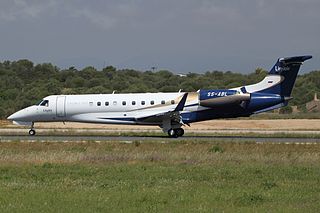Related Research Articles

The peripheral nervous system (PNS) is one of two components that make up the nervous system of bilateral animals, with the other part being the central nervous system (CNS). The PNS consists of nerves and ganglia, which lie outside the brain and the spinal cord. The main function of the PNS is to connect the CNS to the limbs and organs, essentially serving as a relay between the brain and spinal cord and the rest of the body. Unlike the CNS, the PNS is not protected by the vertebral column and skull, or by the blood–brain barrier, which leaves it exposed to toxins.

The pancreas is an organ of the digestive system and endocrine system of vertebrates. In humans, it is located in the abdomen behind the stomach and functions as a gland. The pancreas is a mixed or heterocrine gland, i.e., it has both an endocrine and a digestive exocrine function. 99% of the pancreas is exocrine and 1% is endocrine. As an endocrine gland, it functions mostly to regulate blood sugar levels, secreting the hormones insulin, glucagon, somatostatin and pancreatic polypeptide. As a part of the digestive system, it functions as an exocrine gland secreting pancreatic juice into the duodenum through the pancreatic duct. This juice contains bicarbonate, which neutralizes acid entering the duodenum from the stomach; and digestive enzymes, which break down carbohydrates, proteins and fats in food entering the duodenum from the stomach.

The stomach is a muscular, hollow organ in the gastrointestinal tract of humans and many other animals, including several invertebrates. The stomach has a dilated structure and functions as a vital organ in the digestive system. The stomach is involved in the gastric phase of digestion, following chewing. It performs a chemical breakdown by means of enzymes and hydrochloric acid.

Branko Grünbaum was a Croatian-born mathematician of Jewish descent and a professor emeritus at the University of Washington in Seattle. He received his Ph.D. in 1957 from Hebrew University of Jerusalem in Israel.

The transverse plane is an anatomical plane that divides the body into superior and inferior sections. It is perpendicular to the coronal and sagittal planes.

Los Angeles Metro Bus is the transit bus service in Los Angeles County, California operated by the Los Angeles County Metropolitan Transportation Authority (Metro). In 2022, the system had a ridership of 197,950,700, or about 692,500 per weekday as of the second quarter of 2023.

The gastric glands are glands in the lining of the stomach that play an essential role in the process of digestion. All of the glands have mucus-secreting foveolar cells. Mucus lines the entire stomach, and protects the stomach lining from the effects of hydrochloric acid released from other cells in the glands.
SegaSoft, originally headquartered in Redwood City, California and later San Francisco, was a joint venture by Sega and CSK, created in 1995 to develop and publish games for the PC and Sega Saturn, primarily in the North American market.

The interspinous ligaments are thin, membranous ligaments that connect adjoining spinous processes of the vertebra in the spine. They take the form of relatively week sheets of fibrous tissue are well developed only in the lumbar region.

Aguenar – Hadj Bey Akhamok Airport, also known as Aguenar Airport or Tamanrasset Airport, is an airport serving Tamanrasset, a city in the Tamanrasset Province of southern Algeria. It is located 3.6 nautical miles northwest of the city.

The mouth, also known as the oral cavity, or in Latin cavum oris, is the opening through which many animals take in food and issue vocal sounds. It is also the cavity lying at the upper end of the alimentary canal, bounded on the outside by the lips and inside by the pharynx. In tetrapods, it contains the tongue and, except for some like birds, teeth. This cavity is also known as the buccal cavity, from the Latin bucca ("cheek").
Trigana Air is an airline based in Jakarta, Indonesia.

Linxair was a business airline based in Slovenia. It was established and started operations in 1999 at its base, Ljubljana Jože Pučnik Airport (LJU). Linxair was the fastest-growing aviation company in Slovenian history and the biggest business aviation operator in the area of former Yugoslavia. Due to financial difficulties which started in 2009, the company declared bankruptcy in 2014. Shortly before bankruptcy, the company headquarters were moved from Ljubljana to Slovenj Gradec. A small part of the fleet continued operation under another operator, SiAvia.

An infrared dark cloud (IRDC) is a cold, dense region of a giant molecular cloud. They can be seen in silhouette against the bright diffuse mid-infrared emission from the galactic plane.

Tonlesap Airlines Corp. was an airline with its head office in Phnom Penh, Cambodia. It was a regional carrier operating a scheduled domestic network and regional flights to neighbouring countries. Its main base was Phnom Penh International Airport.

Megadictyon is a genus of Cambrian lobopodian with similarities to Jianshanopodia and Siberion. Occasionally mis-spelt Magadictyon.
Brigitte Irma Servatius is a mathematician specializing in matroids and structural rigidity. She is a professor of mathematics at Worcester Polytechnic Institute, and has been the editor-in-chief of the Pi Mu Epsilon Journal since 1999.

The Requin-class submarines were a class of nine diesel-electric attack submarines built for the French Navy in the mid-1920s. Most saw action during World War II for the Vichy French Navy or the Free French Naval Forces. Nine ships of this type were built in the shipyards of Brest, Cherbourg and Toulon between 1923 and 1928. The class was part of the French Marine Nationale, serving in the Mediterranean Sea. All member ships took part in World War II, fighting on both sides of the conflict; Four were captured by Italian forces and sunk by the Allies. Only one ship survived the war - Marsouin, decommissioned shortly after the war's end.

Comporta, also known as the Comporta Coast, is a region in the northwestern coast of the Alentejo, in Portugal, south of the Lisbon metropolitan area. Comporta is one of the most exclusive summer destinations in Europe, which has earned the region the nickname as "the Hamptons of Europe". The region, which takes its name from the village of Comporta, spans the coastal areas of the Alentejan municipalities of Alcácer do Sal and Grândola.

The ancient legend of Wanglen Pungdingheiba and Sappa Chanu Silheibi is one of the epic cycles of incarnations of Meitei mythology and folklore, that is originated from Moirang kingdom of Ancient Kangleipak. It concerns the tragedic romantic adventures of Wanglen Pungdingheiba for his ladylove Sappa Chanu Silheibi . Wanglen Pungdingheiba was a skilled craftsman known for making musical instrument pung. Lady Sappa Chanu Silheibi was a skilful weaving artisan. Both the lovers are equally noted for their talents and good looks, thereby becoming the matters of envy of many young men and women in the kingdom of Moirang.
References
- ↑ "Interspinous plane – Chemwatch".
- ↑ The Netter collection of medical illustrations. Volume 9, Digestive system Part I, Upper digestive tract. Frank H. Netter, James C. Reynolds (Second ed.). Philadelphia, PA. 2017. p. 8. ISBN 978-0-323-38936-5. OCLC 951909364.
{{cite book}}: CS1 maint: location missing publisher (link) CS1 maint: others (link)